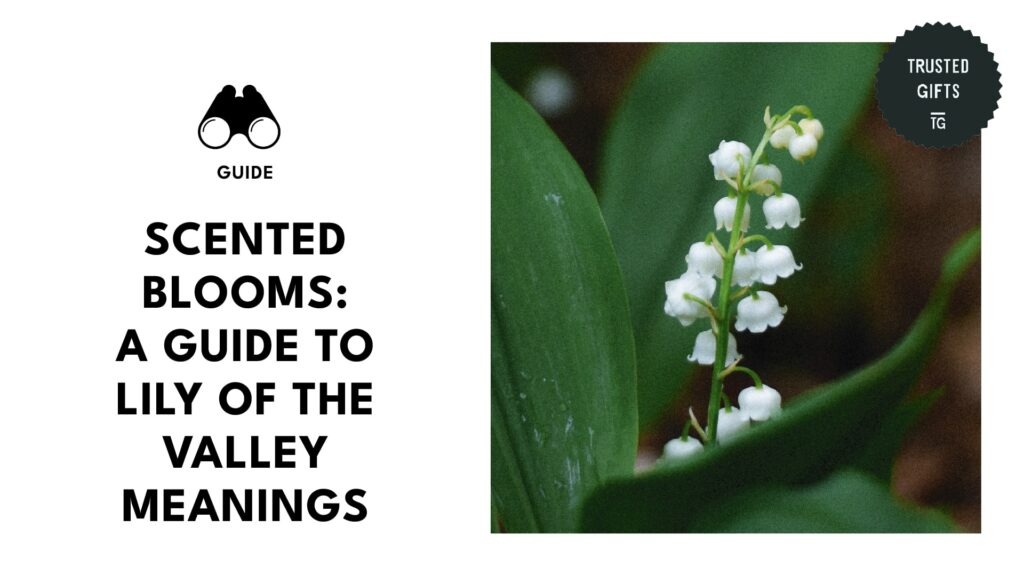The lily of the valley is known for its strong, sweet fragrance and charming appearance. This delicate flower is also rich in symbolism, which makes it a perfect gift or decor for any occasion.
In this guide, we will take you through everything you need to know about this flower’s meanings, significance, origin, preferred growing conditions, and various uses.
Whether you’d like to gift a bouquet to a loved one or beautify your home and garden, the lily of valley has so much to offer!
How did the lily of the valley flower get its name?
The lily of the valley flower, scientifically known as Convallaria majalis, is named as such because it looks like a lily and is commonly found in valleys.
The term “Convallaria” comes from the Latin word “convallis,” which means “valley,” emphasizing its preference for cool and shaded valley settings.
The term “majalis” comes from “maius,” which refers to the month of May. This is the month when lily of the valley flowers burst into bloom.
What are the botanical origins of the lily of the valley flower?
The Convallaria majalis, commonly known as lily of the valley, is a member of the Convallaria genus in the Asparagaceae family.
It’s a perennial plant that’s native to the temperate regions of Europe and Asia and has become widely cultivated in North America.
This flower has slender, gracefully curving stems and clusters of delicate, bell-shaped blossoms. Although lily of the valley flowers are usually white, they may also come in different colors, such as pink and purple.
Where do lily of the valley flowers grow?
Lily of the valley flowers grow in woodlands beneath tall trees that cast dappled shade. They frequently form a lush carpet on the forest floor below the tree canopies.
Do lily of the valley flowers require a lot of maintenance?
The lily of the valley flower is a low-maintenance plant, which makes it a fantastic option for bouquets and floral arrangements to be given as gifts or for decorating your home.
Once it’s established, it doesn’t need a lot of attention, letting you enjoy its aesthetic with minimal effort.
However, be sure to still do some basic maintenance routines, such as watering and occasional fertilizing, to ensure the flower’s health and extend its lifespan.
Do lily of the valley flowers need shade or sun?
The lily of the valley flower prefers to grow in areas with partial shade, which makes it a great choice for gardens with gentle, filtered sunlight or spots that bask in the morning sun and then get shaded in the afternoon.
While it can tolerate some direct sunlight, extended periods of intense heat or full sun could lead to wilting.
When do lily of the valley flowers bloom?
Lily of the valley flowers bloom in the spring and summer months.
What kind of soil do lily of the valley flowers prefer?
Lily of the valley thrives in moist, well-draining soil that’s rich in organic matter. It flourishes in sandy or loamy soil types as long as you keep the moisture levels consistent.
It’s essential that the soil retains its moisture, but be sure not to let it become waterlogged to avoid root rot.
When is the best time to plant lily of the valley flower seeds?
The most common way of propagating lily of the valley is through division.
However, if you want to cultivate them from seeds, it’s best to do it in late summer or early fall.
This timing allows the seeds to undergo a period of cold stratification over the winter months, which boosts their germination rates.
What do lily of the valley flowers mean?
Lily of the valley flowers symbolize joy, innocence, humility, and youth. They also represent motherhood, chastity, good luck, sweetness, and purity.
Lily of the valley is also the birth flower of May, which makes it the perfect gift for May birthday celebrants.
What do the colors of lily of the valley flowers mean?
White


The classic white lily of the valley symbolizes purity and innocence. It represents a pure heart and exudes grace and sophistication.
Additionally, white is also seen as a symbol of new beginnings.
Recommended use: White lily of the valley flowers are ideal for occasions like weddings, anniversaries, and christenings.
Purple


Purple lily of the valley flowers symbolize spirituality, enchantment, and tranquility. They’re also associated with elegance with a touch of mystery.
Recommended use: The purple lily of the valley is an ideal choice for meditation sessions and spiritual gatherings.
Pink


Pink lily of the valley flowers symbolize affection, gentleness, and sweetness. They carry a sense of tenderness and a message of heartfelt emotions.
Recommended use: Pink lily of the valley flowers are a perfect choice for expressing how much you love and admire a person.
What did lily of the valley flowers symbolize in various historical periods?


What are the cultural associations of lily of the valley flowers?


What are the spiritual or religious meanings of lily of the valley flowers?


In Christianity, the lily of the valley is often associated with the second coming of Jesus Christ. This flower is also seen as a representation of a brighter future and as a reminder of purity and the hope for eternal life.
It’s also believed that lily of the valley flowers grew where Mary’s tears fell during Jesus’ crucifixion. They also represent the tears of Eve when she had to leave the Garden of Eden and the tears of Jacob as he mourned the loss of Rachel and Joseph.
What are the uses of lily of the valley flowers?


Lily of the valley flowers have long been used for ornamental purposes and in traditional medicine. They’re also popular in the perfume industry for their fragrance.
Can lily of the valley flowers be used for medicinal purposes?


Yes, extracts from lily of the valley have been applied in traditional medicine for their possible diuretic and heart-stimulating qualities.
Nevertheless, it’s important to note that because of its toxic nature, the plant should never be consumed or used without proper guidance from a qualified healthcare expert.
How can lily of the valley flowers be used in gardening and landscaping?


Here are some creative ways to use lily of the valley flowers in your outdoor spaces:
- Grow them as ground cover: Lily of the valley is known for its ability to form a lush carpet of greenery and fragrant blossoms. Use it as ground cover in shaded areas along walkways where it can create a serene and inviting atmosphere.
- Use them along garden borders and edges: Planting lily of the valley along borders and garden edges can add a touch of elegance to your landscaping. The graceful arching stems and white flowers provide a soft, natural boundary.
- Add them to woodland gardens: If you have a woodland garden or a shaded area in your yard, lily of the valley is an ideal addition. Its preference for cool, shaded environments makes it a perfect match for these settings.
- Grow them in containers: While lily of the valley is typically planted directly in the ground, you can also cultivate it in containers. This allows you to enjoy the fragrance and charm of the flowers on a patio, balcony, or anywhere you desire.
- Use them for companion planting: Pair lily of the valley with other shade-loving plants like hostas, ferns, and astilbes to create a visually appealing and harmonious garden composition.
- Add them in rock gardens: For a unique twist, consider planting lily of the valley in a rock garden. The contrast between the rugged rocks and the delicate blooms can be visually striking.




